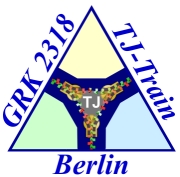
DFG Research Training Group "TJ-Train" (GRK 2318/2) Project
B1
Prof. Dr. Thomas Willnow
Max-Delbrück-Centrum für Molekulare Medizin (MDC), The endocytic receptor LRP2 serves as a central hub for dynamic cellular remodelling in neuronal stem cells and neural crest cells in the developing neural tube
Our recent results indicate towards a crucial role of LRP2 as a central hub in the periciliary compartment of neuroepithelial cells for establishing morphology, polarity and ultimately specification of neuronal progenitors. We showed that LRP2 functionally interacts with intracellular adaptor scaffold proteins and actin binding proteins that are involved in dynamic cell shape, apical constriction and planar cell polarity, processes that are crucial for neural tube closure. Moreover, we identified LRP2 in neural crest cells. Interestingly LRP2 deficient embryos show impaired cranial neural crest migration patterns suggesting an important role of the receptor not only in neuroepithelial cell specification but also in neural crest cell fate determination. Hypothesis : LRP2 functionally interacts with intracellular cellular scaffolds and thereby serves as a hub to regulate single and collective cellular dynamics in polarized epithelia that involve rearrangements of the cytoskeleton and cell-cell junctions, including tight junctions.Aims, Work Plan and Methods: At a cellular level we will try to understand the molecular and cell biological LRP2 dependent mechanisms responsible for neuroepithelial cell polarity and apical constriction, a prerequisite for proper neural tube formation. In addition, we will investigate the influence of LRP2 function on neural crest cell motility and cell fate decisions. In specific, we will address how the endocytic receptor LRP2 and its intracellular adaptor scaffold proteins affect cytoskeleton rearrangements and cell-cell connections and thereby confer neural tube formation as well as directed migration of neural crest cells.Using mouse models and ex vivo explant cultures, we will employ various approaches based on molecular biology and imaging techniques. A strong focus will be on high and super resolution imaging to characterize details in the interaction of cellular components in neuroepithelial and neural crest cells. We are closely collaborating with project A4 (Martin Lehmann, Volker Haucke) optimizing super resolution imaging (STED) on whole mount embryos and explant cultures. Suggested reading: See Project-related publications, especially Refs. 1, 2, and 4 3rd cohort PhD doctoral student 2nd cohort PhD doctoral student Sher Min Mak
1st cohort PhD doctoral student Izabela Kowalczyk
Project-related publications
Christ A, Christa A, Klippert J, Eule JC, Bachmann S, Wallace VA, Hammes A, Willnow TE (2015) LRP2 acts as SHH clearance receptor to protect the retinal margin from mitogenic stimuli. Breiderhoff T, Himmerkus N, Stuiver M, Mutig K, Will C, Meij IC, Bachmann S, Bleich M, Willnow TE, Müller D (2012) Deletion of caudin-10 (Cldn10) in the thick ascending limb impairs paracellular sodium permeability and leads to hypermagnesemia and nephrocalcinosis. Christ A, Christa A, Kur E, Lioubinski O, Bachmann S, Willnow TE, Hammes A (2012) LRP2 is an auxiliary SHH receptor required to condition the forebrain ventral midline for inductive signals. Willnow TE, Christ A, Hammes A (2012) Endocytic receptor-mediated control of morphogen signaling. Kur E, Christa A, Veth KN, Gajera CR, Andrade-Navarro MA, Zhang J, Willer JR, Gregg RG, Abdelilah-Seyfried S, Bachmann S, Link BA, Hammes A, Willnow TE (2011) Loss of Lrp2 in zebrafish disrupts pronephric tubular clearance but not forebrain development. Christ A, Terryn S, Schmidt V, Christensen EI, Huska MR, Andrade-Navarro MA, Hübner N, Devuyst O, Hammes A, Willnow TE (2010) The soluble intracellular domain of megalin does not affect renal proximal tubular function in vivo. Gajera CR, Emich H, Lioubinski O, Christ A, Beckervordersandforth-Bonk R, Yoshikawa K, Bachmann S, Christensen EI, Götz M, Kempermann G, Peterson AS, Willnow TE, Hammes A (2010) Ependymal cells regulate BMP signaling in the adult neurogenic niche through LRP2. Zhang J, Piontek J, Wolburg H, Piehl C, Liss M, Otten C, Christ A, Willnow TE, Blasig IE, Abdelilah-Seyfried S (2010) Estabilshment of a neuroepithelial barrier by claudin5a is essential for zebrafish brain ventricular lumen expansion. Anzenberger U, Dehmel B, Bit-Avragim N, Rohr S, Willnow TE, Abdelilah-Seyfried S (2006) Elucidation of Megalin/LRP2-dependent endocytic transport processes in the larval zebrafish pronephros. Hammes A, Andreassen TK, Spoelgen R, Raila J, Huebner N, Schulz H, Metzger J, Schweigert F J, Luppa PB, Nykjaer A, Willnow TE (2005) Impaired development of the reproductive organs in mice lacking megalin, an endocytic receptor for steroid hormones. Cell 122: 751-762 |